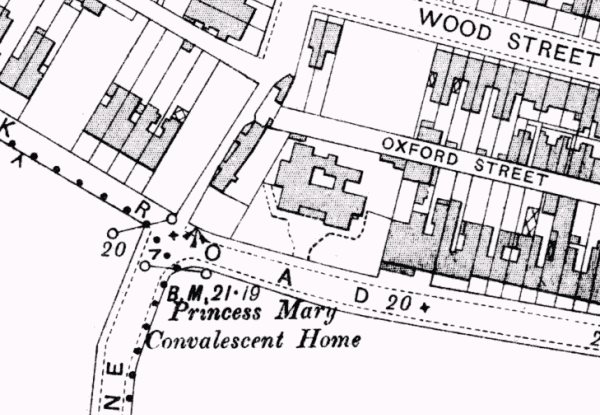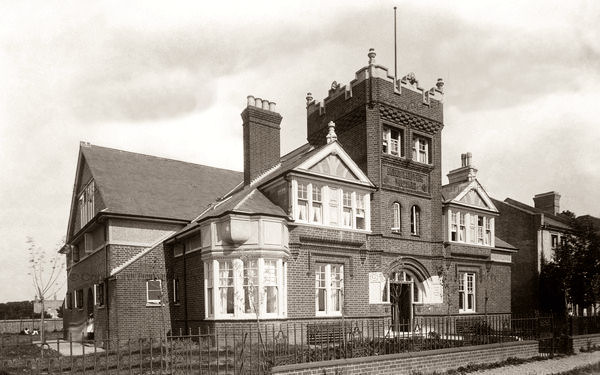Arthur's Home, Bognor Regis, Sussex
In July 1893, the London Ragged School Union opened a holiday/convalescent home, named Arthur's Home, at 120 Aldwick Road, Bognor Regis. Below is an abridged contemporary report of the opening:
The fine building which during the past six months has been in course of erection in the Aldwick-road, Bognor, was opened for use as Holiday Home for children in connection with the London Ragged School Union last Saturday afternoon in the presence of a number of London and local friends. The Home and also the land upon which it has been built are, it is understood, the gift of a London lady, who however wishes to remain anonymous, in loving memory of a man whose one great desire was "to make some children happy." Both in the choice of site and particularly in the erection of the building a special effort has been made to benefit the children to the greatest extent possible and so to carry out the desire which led to the establishment of the Home in its fullest and widest sense. Short and ready access to the country and sea shore are afforded by its position and an exceptional opportunity of obtaining plenty of pure fresh air indoors as well as out. The building stands on a plot of ground some 120 feet square. in which sufficient space has been left for a good sized playground; outside it is of a mixed gothic style and the presence of a tower above in red brick and stone walls gives it a distinctive appearance. Upon the front of the tower are the words "Arthur's Home." Below on one side of the chief entrance the phrase "In loving memory" have been cut in the white stone and on the other side the object of the Home, "To make some children happy," is stated in a similar way. Inside the building the leading idea is to obtain as much cubic air space as possible, and with this object in view, no door or anything of that kind has been constructed between the Central Hall down stairs where the children will have their meals and remain whilst indoors in the daytime, and the sleeping compartments or cubicles above. In the tower is a dormitory containing six beds for elder girls, who in this position will be able to look down and maintain order among the younger children. There is sleeping accommodation for over 50 children as well as for the matron and her staff of assistants. A special room is also reserved for the matron downstairs with another for the reception of visitors. The kitchen and its necessary adjuncts are within easy reach of the central hall, on one side, and so are the lavatories on the other. Concrete has been used in the flooring throughout the building so as to make it fire proof as far as possible. The cost of the whole it is stated has been £2,800 —£300 for the land and £2,500 for the building and furnishing. At present there are several holiday homes carried on by the London Ragged School Union. but this is the first that has become the property of the Union. A small provision for the future maintenance of the Home has we understand been made by the donor, but its work will to a great extent depend upon voluntary contributions, and therefore it is earnestly hoped that a large number of kind friends will come forward with financial as well as sympathetic support. By these means the poor children of our great metropolis, who live daily under influences deteriorating both to body and mind, will be enabled to spend two weeks in the year at a seaside home where their bodily wants will be liberally supplied, where they will be surrounded by all thee speaks to them of the great Creator, and from which they will be sent back to their homes with a " rose of nature's own painting " on their cheeks so that their friends will hardly recognise them. The first lot of children it was arranged should come down to the Home yesterday.
Mr. W. J. Ancell (the Architect) gave a few particulars concerning the erection of the Home. The building he said was based upon the municipal principle of accommodation for the poorer classes, of obtaining as much cubic air space as possible and so doing away with the evils of overcrowding. It would be very unhealthy for 40 children to sleep in one room, and it occurred to him that it would be a good plan to construct the dining hall and the sleeping accommodation so as to combine without interception the cubic air space of both. At night each child would have a cubicle to himself in which he would have the benefit of about four times the amount of cubic air space that an ordinary bedroom mid give. Under these circumstances a child coming to such a place for a fortnight’s change could not fail to obtain an immense amount of good, the central hall would do in a play room indoors as well as for meals. Then were also bedrooms for visitors and the staff And separate lavatories for the boys and the girls. At the last moment they addled a dormitory for bigger children. The arrangements for washing were very simple, but he doubted whether they were simple enough. He was of opinion that washing under a tap would be better than in the basin, because by the latter, one child might take anything infectious from another. For a child to put his head under a tap—well it was primitive he knew but where there were so many together it was the best way.
The name of the matron appointed to take charge of the Home is Miss Widgington.
The home's site is shown on the 1912 map below.

Arthur's Home site, Bognor Regis, c.1912.

Arthur's Home, Bognor Regis, Sussex, c.1900.
The property is now a care home known as Ashley House.
Records
Note: many repositories impose a closure period of up to 100 years for records identifying individuals. Before travelling a long distance, always check that the records you want to consult will be available.
- The London Metropolitan Archives, 40 Northampton Road, London, EC1R 0HB now holds the archives of the Shaftesbury Homes and Arethusa Training Ship. More details in their online catalogue entry.
Bibliography
- Bailey, Marion Chance of a Lifetime - the Story of the Shaftesbury Homes and Arethusa (1996, Dianthus Publishing)
- Cuthbert, V Where Dreams Come True: A Record of 95 Years (1937, London: Shaftesbury Homes and "Arethusa" Training Ship)
- Higginbotham, Peter Children's Homes: A History of Institutional Care for Britain's Young (2017, Pen & Sword)
- Hodder, Edwin The Life and Work of the Seventh Earl of Shaftesbury, K.G. (1886, Cassell)
Links
Except where indicated, this page () © Peter Higginbotham. Contents may not be reproduced without permission.


